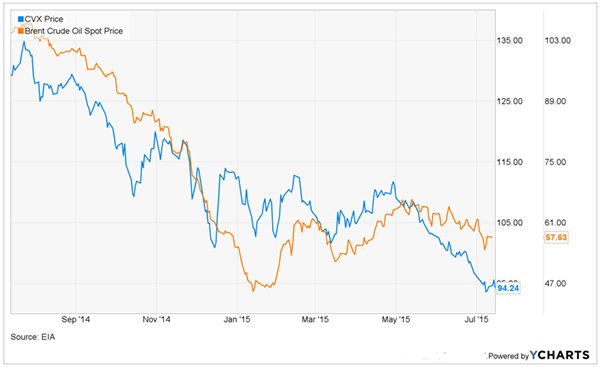Most value investing articles share one clear theme: Any company firing on all cylinders won't trade for single -digit price-to-earnings ratios. Low valuations are typically applied to companies that have a deep set of problems.
Whether it is a company-specific, industry-specific or economy-specific problem, a key impediment is in the way. The challenge is identifying great companies that are experiencing near-term difficulties, but have a defined path to improve financial results. Patient investors who can achieve that are often rewarded with capital gains and dividend raises.
Chevron Corp. (NYSE: CVX) is a perfect example of a great company facing industry specific problems. In the first quarter of 2014, the average price of a barrel of oil Chevron sold was more than $98 per barrel, but in Q1 of 2015, the average price of a barrel of oil was down to just over $48.
Chevron is extremely sensitive to the price of oil. The company estimated that from quarter to quarter, operating cash flow can rise or fall between $325 million-to-$350 million for every dollar change in the price of crude oil. Naturally, Chevron saw its share price fall alongside the price of oil.

The free fall in the stock has pushed Chevron's dividend yield up above 4.25%. A number that has a lot of significance if history is any indication. In the previous 21 years, investors have only had the opportunity to purchase Chevron with a starting yield above 4.25% four times -- including today.

Chevron has never cut its quarterly dividend over these 21 years. Instead, these 4.25% dividend yield opportunities arose only when the market's pessimism drove the stock price down to extremely depressed levels, similar to the situation today.
If you had invested in Chevron in any of the three previous instances of such a high yield, you would have earned fabulous returns, trouncing the long-term average of the S&P 500 despite today's tough operating environment.
| ||||||||||
| Source: Longrundata.com |
Investing In Growth
Although Chevron is slowing the development of certain growth projects (as a result of lower realized oil and gas prices), it is 'zigging' as the rest of the industry 'zags' by continuing to commit billions to growth projects. It expects to grow production faster than any other major firm in the industry over the next two years.

Chevron's most exciting projects are the Gorgon and Wheatstone liquefied natural gas fields. Processing facilities in that region will produce more than 25 million metric tons of liquefied natural gas annually when running at full capacity.
This energy complex is in Australia and is well-positioned to service Asia, which currently has a spot price for natural gas that is two to three times higher than the wholesale price of natural gas in the United States. These projects will add a huge amount of higher-margin production capacity and will be hugely profitable for shareholders.
Investors are concerned about Chevron's short-term prospects, but history has shown that every time this happens, bold investors who buy when everyone else is selling outperform the market. So is now the time to buy? Chevron's high yield and depressed valuations suggest that's the case.
Risks To Consider: Chevron is investing heavily in growth projects. An extended period of low oil and gas prices could eventually cause the company to reverse course on recent growth initiatives. The low profitability would likely keep the dividend frozen too.
Action To Take --> Chevron is a juggernaut and despite low oil prices it still earns several billion dollars every quarter. Oil prices only need to rise modestly for Chevron's profit and cash flow levels to rise much higher. History says this is a good time to buy and I agree. Chevron is a terrific buy under $100 with a current yield of 4.6%.
If oil, natural resources or commodities are what interests you, look no further than StreetAuthority's Scarcity & Real Wealth. Our resident natural resources expert Dave Forest has more than a decade's experience as a trained geologist and analyst. His industry insight allows him to read the markets and provide the most timely, potentially lucrative advice for everything from oil and gold to molybdenum. Most recently, Dave has been talking about a rally in gold prices. To gain access to Dave's latest research, click here.



